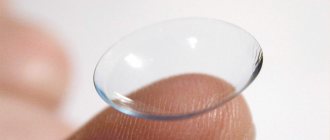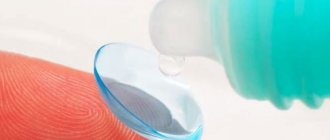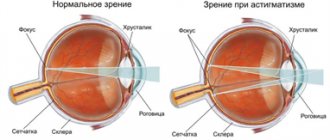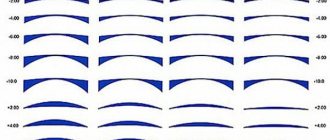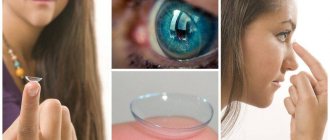Hydrogel lenses
The main substance is water, so the lenses are not hard and do not cause discomfort when worn. They retain moisture and form a protective film. They have a small elastic modulus and oxygen transmission coefficient.
Products are manufactured for vision correction. The material used for production does not cause allergic reactions or rejection. It is soft, there is no feeling of discomfort and is not felt on the eyes.
The lenses are thin and do not move or curl when blinking. Do not interfere with the work of the upper eyelid. Hydrogel is an elastic and elastic material that does not cause additional pressure on the cornea.
Wearing period: one day, two weeks, monthly and quarterly, long-term use. The optics have a spherical design, but can also be found with an aspherical one.
Examples of lenses:
- DAILIES AquaComfort Plus;
- Biomedics 55;
- 1 day ACUVUE MOIST;
- Optima FW.
Flaws
Water evaporates quickly when worn, causing discomfort to the user. Some people have to carry moisturizing drops with them. These vision correction products have low oxygen permeability.
This is the main drawback. It does not allow flexible or extended wear of hydrogel lenses.
The optics are not suitable for night mode. Before going to bed, they are removed because CLs are not able to transmit oxygen sufficiently.
The contact lens does not have its own blood vessels; the necessary oxygen comes from the air. With prolonged use, hydrogel products lead to oxygen deficiency and the development of hypoxia.
Such optics quickly accumulate protein and fat deposits. It must be washed daily with a special solution.
There are reasons to switch to silicone hydrogel lenses!
Silicone hydrogel lenses have been actively used by specialists in the field of contact vision correction, who care about the safety and comfort of their patients, for more than 10 years. The fact that wearing lenses of this particular type is preferable to using conventional hydrogel lenses has also been proven by those who have studied them in clinical settings. Over time, technology developed and silicone hydrogel lenses appeared, capable of not only excellent oxygen transmission, but also having a low elasticity modulus, a high degree of moisture and other properties important for eye health and comfort, which contributed to increasing the differences between them and hydrogel lenses. means of contact correction. Let's look at which lenses are the best and for what reasons, why it is worth switching to wearing lenses made of silicone hydrogel materials, and which contact correction products of this type should be purchased by the Russian consumer.
Good oxygen permeability helps reduce complications.
Many experts consider the most important reason for choosing silicone hydrogel lenses to be the high level of oxygen transmission to the cornea (Dk/t). Due to this, the likelihood of developing corneal hypoxia is significantly reduced compared to wearing lenses made of hydrogel material. A 2007 study by Dr. Peter Bergenske found that the eye health of patients who wore silicone hydrogel lenses for 30 days and nights was better than those who wore hydrogel contact lenses during the day. . The former had much less pronounced signs of hypoxia (neovascularization, corneal edema, redness) than the latter. Among the patients of the first group there were much fewer complaints about deterioration in vision clarity, photophobia, foreign body sensation, dry eyes, etc.
Everyone knows that not all people have the same corneal oxygen demand. Therefore, it is difficult to clearly determine in advance which lenses are the best for each specific patient. But, anyone who decides to wear contact correction products can choose contact optics with a high Dk/t index.
This is especially true for patients with astigmatism, presbyopia, and high degrees of hyperopia/myopia who require lenses that are thicker than average. Also, silicone hydrogel lenses are better for those who tend to periodically fall asleep with their contact lenses on, even during the day.
Ensuring wearing comfort
As a result of clinical studies, it has been proven that silicone hydrogel lenses are the most comfortable for a number of reasons.
1) A high Dk/t value prevents the possibility of developing signs of corneal hypoxia.
2) The low moisture content of silicone hydrogel contact correction products contributes to less rapid dehydration of fluid from the surface of the eye and contact lens.
3) The surface of these lenses is treated with a special method, and they also contain moisturizing agents, due to which they remain moisturized for a long time.
That is why, when wearing silicone hydrogel lenses, unlike hydrogel lenses, there is less discomfort, which is why many believe that silicone hydrogel lenses are the best.
Such statistics are fully justified: the latest achievements and the most advanced technologies are used in the production of contact correction products from silicone hydrogel material. The high Dk/t indicator is far from their only advantage.
There are reasons to switch to silicone hydrogel lenses! Silicone hydrogel lenses have been actively used by specialists in the field of contact vision correction, who care about the safety and comfort of their patients, for more than 10 years. The fact that wearing lenses of this particular type is preferable to using conventional hydrogel lenses has also been proven by those who have studied them in clinical settings.
Over time, technology developed and silicone hydrogel lenses appeared, capable of not only excellent oxygen transmission, but also having a low elasticity modulus, a high degree of moisture and other properties important for eye health and comfort, which contributed to increasing the differences between them and hydrogel contact correction products. Let's look at which lenses are the best and for what reasons, why it is worth switching to wearing lenses made of silicone hydrogel materials, and which contact correction products of this type should be purchased by the Russian consumer.
Good oxygen permeability helps reduce complications. Many experts consider the most important reason for choosing silicone hydrogel lenses to be the high level of oxygen transmission to the cornea (Dk/t). Due to this, the likelihood of developing corneal hypoxia is significantly reduced compared to wearing lenses made of hydrogel material.
A 2007 study by Dr. Peter Bergenske found that the eye health of patients who wore silicone hydrogel lenses for 30 days and nights was better than those who wore hydrogel contact lenses during the day. . The former had much less pronounced signs of hypoxia (neovascularization, corneal edema, redness) than the latter. Among the patients of the first group, there were much fewer complaints about deterioration in visual clarity, photophobia, foreign body sensation, dry eyes, etc. Everyone knows that not all people have the same need for oxygen in the cornea. Therefore, it is difficult to clearly determine in advance which lenses are the best for each specific patient.
But, anyone who decides to wear contact correction products can select contact optics with a high Dk/t index. This is especially true for patients with astigmatism, presbyopia, high degrees of hypermetropia/myopia, who require wearing lenses whose thickness is above average. Also, silicone hydrogel lenses are better for those who tend to periodically fall asleep with their contact lenses on, even during the day.
Ensuring wearing comfort:
As a result of clinical studies, it has been proven that silicone hydrogel lenses are the most comfortable for a number of reasons.
1) A high Dk/t value prevents the possibility of developing signs of corneal hypoxia.
2) The low moisture content of silicone hydrogel contact correction products contributes to less rapid dehydration of fluid from the surface of the eye and contact lens.
3) The surface of these lenses is treated with a special method, and they also contain moisturizing agents, due to which they remain moisturized for a long time.
That is why, when wearing silicone hydrogel lenses, unlike hydrogel lenses, there is less discomfort, which is why many believe that silicone hydrogel lenses are the best. Such statistics are fully justified: the latest achievements and the most advanced technologies are used in the production of contact correction products from silicone hydrogel material. The high Dk/t indicator is far from their only advantage.
Silicone hydrogel lenses
Hydrogel contact lenses are gradually being replaced by innovative developments. Silicone hydrogel CLs have practically eliminated the problem of oxygen starvation, since they allow enough oxygen to pass through. The optics allow 6 times more oxygen to pass through than the hydrogel.
This ensures normal metabolism and prevents oxygen starvation.
Advantages:
- high level of comfort during wearing;
- the organs of vision are not subject to dehydration;
- suitable for drivers, people working with computers and people who work in areas with increased dust or dryness;
- lead to a significant reduction in limbal hyperemia;
- the use of disinfectant compounds and moisturizing drops does not affect the condition of the surface of the product created as a result of plasma treatment.
Wearing mode: flexible, extended and daytime. Sometimes you can leave the lenses in overnight. Extended wear products can be left in place for 7 days.
Moisture content level up to 45%. There is no need to use moisturizing drops.
Best product samples:
- Johnson&Johnson 1-Day Acuvue TruEye;
- ClearLux One Day Aspheric;
- Air Optix for Astigmatism;
- PureVision 2;
- Biofinity XR.
Minuses
Silicone hydrogel lenses are not without their disadvantages. Silicone contained in the optical product may cause allergic reactions. Causes redness, irritation, burning and itching in some users.
The optical product is resistant to the accumulation of fatty deposits. But protein deposits accumulate. Silicone hydrogel lenses are cleaned daily. For beginners who have previously used conventional optics, silicone hydrogel products may seem harsh.
Adaptation is quick, discomfort goes away after 2-3 applications. For silicone hydrogel CLs, it is necessary to use an appropriate multifunctional solution. Incorrect selection of fluid leads to relatively asymptomatic staining of the cornea. Maximum staining occurs after 2 hours, decrease occurs after 6 hours.
Which material to choose
The only difference between the materials is that silicone hydrogel optics contain silicone. The properties of the materials differ slightly.
Oxygen permeability is better in silicone hydrogel vision correction products, but they are stiffer, so wearing comfort is less and adaptation is required. Rigidity appears due to the presence of silicone in the composition.
In addition, they are not suitable for users with allergic reactions to this material.
The main advantage of SGL is oxygen permeability and the possibility of flexible and prolonged wearing. The advantage of GL is its high moisture content, resistance to protein deposits and the purchase of less expensive solutions for disinfection.
Which material to choose depends on the user. If lenses are purchased for long-term or extended wear, silicone hydrogel lenses are suitable. If the patient is more concerned about comfort, quick adaptation and low cost, purchase gypsum plasterboards.
How to choose?
To select a CL, you need to consult an ophthalmologist, who will recommend specific models, determine the required optical power, and also identify possible contraindications. CLs are not recommended to be worn if you have allergies, inflammatory diseases and glaucoma. The most important thing when choosing lenses for your eyes is comfort. If a person experiences discomfort for more than 15-20 minutes, then the model was chosen incorrectly. To get used to optics at home, you can buy one pair of daily lenses. After choosing a product, you must follow the wearing regimen and care rules.
Consumer Reviews
Valentina: Over 20 years of using hydrogel lenses, I have encountered a lot of problems. I decided to switch to silicone hydrogel. They are softer, contain more water, and are more comfortable. I use it every day, and they feel like one-day products. I don’t feel any discomfort at all, even after the end of the working day.
Svetlana: My first experience with contact lenses was unsuccessful. I constantly felt hydrogel products in my eye, and in the evening dryness appeared. I bought CooperVision Biofinity for periods. They are thin, I can wear them almost always, my eyes are moisturized and do not redden.
Stanislav: My eyes are hard to please in terms of lenses. I tried both types, but I liked the silicone hydrogel ones better. Thinner, more comfortable. There is one drawback - they tear easily and are difficult to remove.

